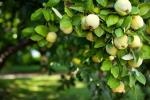Rhododendrons are real eye-catchers in every garden. But you have to be well informed about their requirements so that they also bloom magnificently.

The Rhododendron (rhododendron) is a versatile plant that geographically covers a large space. Its flowers shine in many bright colors and delight the minds of many hobby gardeners. The deciduous, semi-evergreen, or evergreen shrub of the heather family (Ericaceae) is a great addition to any garden. We will tell you how you can make the rhododendron at home in your garden and what you should consider.
contents
- Rhododendron species and varieties
-
Buy rhododendrons
- Buying rhododendrons: Watch out for pests and diseases
- Buying rhododendrons: Examine the roots
- Rhododendron: The right location
- The right soil for rhododendrons
- Plant rhododendrons
- Rhododendron in a pot for the balcony or terrace
-
Caring for rhododendrons
- Water the rhododendron
- Fertilize rhododendrons
- Cut rhododendrons
-
Rhododendron: Common Pests and Diseases
- Rhododendron Cicada
- vine weevil
-
leaf spot disease
- powdery mildew
Rhododendron species and varieties
With more than 1,000 species worldwide, the rhododendron genus is one of the largest shrub genera. It is therefore not surprising that there are countless types and varieties for home and garden to buy. We have put together a small selection of the most popular types and varieties for you.
Rhododendron subgenus Azaleastrum
Shrubby varieties with tall growth (up to 5 m); flowering time between March and April; mainly white bloom; hardy to -12 °C
Rhododendron subgenus Hymenanthes
growth habit tree-like; rather unpopular in German gardens; partly hardy to -15 °C; flowering between January and May; mostly pink to strong red flowers
Rhododendron subgenus Therorhodia
Dwarf shrub species (between 30 and 40 cm); some species hardy to -30 °C; flowering time between May and June; partly bicolored flower (pink-violet; rare white, pink or red)

Popular rhododendron varieties:
- 'Cunningham White'
Large-flowered hybrid; large white flower; relatively site tolerant; frequent finishing on INKARHO base; grows over 2 m high - 'Nova Zembla'
Large-flowered rhododendron; robust and hardy; flowers in soft pink to strong red; Flowers have dark spot patterns -
'bloombux'
Hybrid; evergreen variety; is offered as a boxwood alternative; very easy to care for and rich in flowers; Flowering in April/May
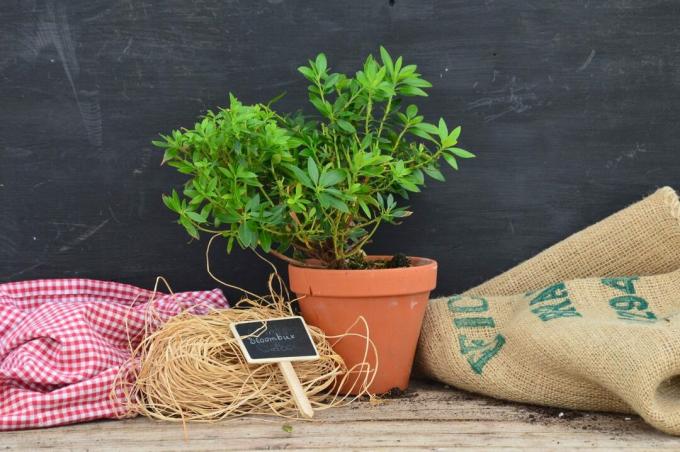
More information about the 20 most beautiful rhododendron species and varieties you'll find here.
Buy rhododendrons
You can already make a few mistakes when buying your rhododendron specimen. The selection of the plant sometimes decides whether the cultivation of rhododendrons in your own garden will be successful or not. We'll use a few simple tips to explain how to choose the best plant for your garden.
Buying rhododendrons: Watch out for pests and diseases
The rhododendron is predestined for attack by fungal diseases. Small yellow lesions and wilted leaves, for example, indicate the common leaf spot disease, but Phytophtara wilt is also a serious disease in rhododendrons. In addition, some animal pests cause problems for the rhododendron, including the rhododendron cicada. However, the cicada itself acts more as a vector for fungal diseases by creating entry points in the buds by laying eggs. So when you buy your rhododendron, make sure that the plant is free of lesions and small animals. However, if you buy from a specialist, the probability of an infestation with diseases is very low.
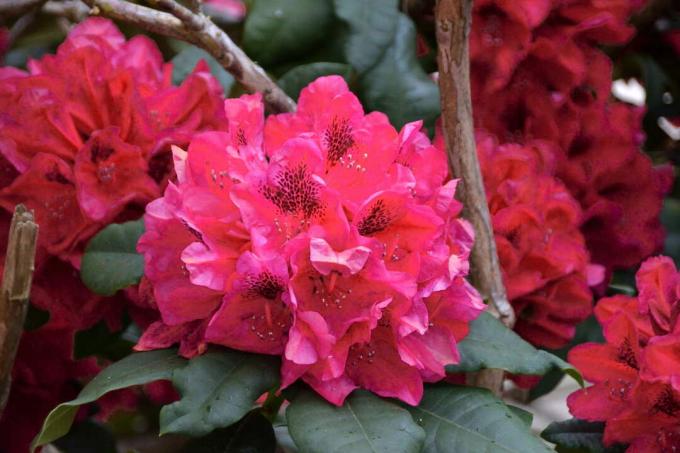
Buying rhododendrons: Examine the roots
For more than twenty years, breeders have been working on being able to plant rhododendrons in neutral and slightly alkaline locations. By grafting a wide variety of varieties on a rootstock of lime-tolerant varieties, it has been possible to breed so-called INKARHO rhododendrons. These form a stronger root system and can therefore be planted on almost any soil. So when you buy it, look out for the name "INKARHO" so that you can look forward to lush flowers in your garden.
Tip: Even if you find slightly acidic soil in your own garden, an INKARHO variety is a good choice. Due to its strong, extensive root system, faster and more vigorous growth can often be observed, which is also reflected in magnificent flowers.
All information about Buying the right rhododendron we have put together for you here.
Rhododendron: The right location
The rhododendron originally comes from higher regions. There are special conditions to which today's varieties for the garden are still well adapted. We will briefly tell you the most important things about choosing the right place for your rhododendron.

The rhododendron tolerates direct sunlight well under certain conditions. If the soil is of the right quality and a continuous water supply is guaranteed, your darling can also withstand hot weather. In very long periods of heat, which are associated with drought, the rhododendron prefers partial shade in the protection of larger trees and shrubs.
The right soil for rhododendrons
The rhododendron is used to growing on shallow and rather acidic locations. These properties result from its origin in higher geographic locations. For the perfect location in the garden, this means: loosen the soil well and mix it with lots of humus. The humus slightly acidifies the soil and ensures good permeability and an optimal grain size spectrum. Since the shallow soils in mountainous areas are often very permeable, it makes sense to work a drainage layer of gravel into the planting hole. Here you can find out more about the right soil for rhododendrons.

Plant rhododendrons
The rhododendron is undoubtedly one of the most cultivated evergreen garden perennials. This actually suggests that its planting and care requirements are comparatively low. On the contrary: there are a few things to consider when planting rhododendrons. We explain step by step what is important:
1. Dig a planting hole
The rhododendron is a sensitive flat-rooted plant that loves permeable and slightly acidic soil. Therefore, dig a spacious planting hole (about three times the diameter of the root ball) and enrich the soil with peat or special rhododendron soil (and if necessary with coffee grounds) to the soil to acidify. Furthermore, with heavier soils, a drainage layer of gravel should be laid at the bottom of the planting hole, or at least half of the filler soil should be replaced with sand. This increases the particle size range and prevents waterlogging.
2. Plant rhododendrons
The rhododendron is usually sold in a pot with a well-developed root ball. Pull the plant out of the pot with the root ball and place it in the planting hole. Then fill the planting hole with the sand-humus soil mixture until 2 cm of the root ball is still sticking out of the ground, and lightly press down on the loose substance. This will prevent the rhododendron from being planted too deep and possibly dying off the root system.
A more detailed guide to Planting a new rhododendron you'll find here.
As you already have one Properly transplant older rhododendrons, read our special article.
Rhododendron in a pot for the balcony or terrace
Even if you don't have a large garden, that doesn't mean you have to do without rhododendrons. Certain species such as Japanese azaleas and dwarf varieties such as Rhododendron 'Yakushima' are also suitable as a container plant and can therefore be used on the balcony or terrace with their blooms decorate. When choosing the pot for the rhododendron, the following should be considered: the shape of the pot should be wider than high to accommodate root development. Good water drainage should also be ensured. Several holes and a drainage layer are ideal so that the root is never wet and rot is prevented.
You should also think about hibernation in good time. Because even if the rhododendron variety is considered hardy, the cold must never act directly on the roots. And it should not be directly exposed to wind and sun during the winter. However, if you have considered these points, nothing will stand in the way of your rhododendron in the pot.
Caring for rhododendrons
The genus of rhododendrons is generally more at home in acidic locations. If these conditions are not given in your garden, it is advisable to give it a helping hand. We will tell you how you can easily create optimal conditions for your rhododendron. Everything about the Rhododendron care can be found here in our special article.
Water the rhododendron
Rhododendrons are at home on very permeable and shallow soils. This makes them very sensitive to waterlogging. Young plants should still be watered regularly, preferably daily, but without over-saturating the soil.
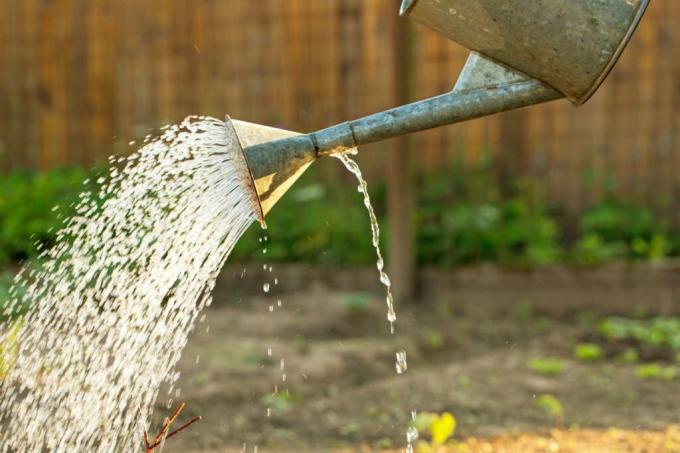
Tip: Several small waterings a day are always the better solution if you are not sure how much to water.
Fertilize rhododendrons
Unlike many other heather plants, the rhododendron is very hungry. That's why you shouldn't let your darling go hungry and fertilize it regularly. However, it is important to choose the right dose at the right time. Experts advise fertilizing young plants that were planted in spring with a long-term fertilizer. Special rhododendron fertilizers or generally applicable, primarily organic fertilizers with a long nutrient release are suitable for this. Many rhododendron experts swear by horn shavings as an additional source of nutrients. Between 20 and 30 grams of horn shavings per square meter are sufficient.
tip: Our Plantura Organic hydrangea fertilizer is a primarily organic organic fertilizer with a long-term effect and is therefore ideal for rhododendrons. The fertilizer releases its nutrients slowly and gently over a period of three months and supplies your rhododendron with iron.
Older established plants are also fertilized at the same time as young rhododendrons planted in spring. In March or April, a long-term fertilizer like our Plantura Organic hydrangea fertilizer applied and, if necessary, fertilized with horn shavings. However, the dose of horn shavings should not exceed 120 grams per square meter.

tip: Anyone who likes to drink coffee and is also a rhododendron fan has found the perfect combination. Coffee grounds have proven to be an excellent fertilizer for rhododendrons because they are completely organic, provide a wide range of nutrients and also slightly acidify the soil. To remove the coffee grounds, simply work them into the surface so that they decompose as quickly as possible.
More information about Fertilizing rhododendrons we have compiled for you in our expert article.
Cut rhododendrons
The rhododendron impresses with its lush flowers and spreading branches. This opulent eye candy does not require regular pruning. However, in order to keep your pet in good shape over the long term, it should be trimmed at irregular intervals. We reveal how it works.
Rhododendron: when and how to cut?
The right time to cut always depends on the reason for the cut. If you would like to carry out maintenance pruning to keep your rhododendron in shape, it is best to do this after flowering, between May and June. However, if a more radical pruning is required because the rhododendron is becoming increasingly bare on the inside, this should be done in autumn or spring. When pruning rhododendrons, a distinction must be made between two cases. On the one hand there is a radical rejuvenation pruning, on the other hand you can keep your rhododendron in shape with a maintenance pruning. We explain what to look out for.
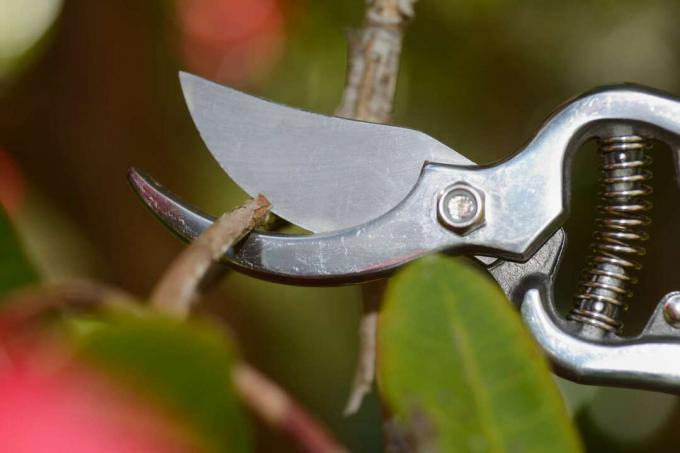
Cutting rhododendrons: How to proceed with maintenance pruning
In order to keep your rhododendron in shape, it is advisable to carry out a rather reserved maintenance or topiary cut. A good time to do this is right after flowering. Here you can estimate the later shape of the bush well, possibly remove part of the withered flowers and damage the bush not too much, so that its photosynthetic performance is not restricted and enough energy is provided for the coming flowering can.
How to proceed: Simply cut the shoots a few centimeters below the tip of the shoot with sharp rose scissors so that you are satisfied with the optical cross-section. Note: The pruning also promotes branching and ensures denser foliage and flowers in the following year.
Pruning rhododendrons: Procedure for rejuvenation pruning
The cold winter months, when the rhododendron remains dormant, is the right time for a comprehensive pruning. To do this, cut back old shoots with sharp rose scissors, exposing inner parts of the bush again so that light can flow in.

The following applies to pruning after flowering: remove diseased and dry shoots, but leave shoots with buds intact. With both types of cut, always cut the shoots at an angle so that dew and rainwater can drain off.
A more detailed guide to Pruning the rhododendron you'll find here.
Note: We always recommend wearing gloves when working on the rhododendron as the shrub is poisonous. More information about poisonous rhododendron get here.
Rhododendron: Common Pests and Diseases
The rhododendron is often attacked by fungal diseases, but insects don't stop at the popular garden shrubs either. We give a brief overview of the most important diseases and pests of rhododendrons.
- Small light green species
- Caused by oviposition Portal of entry for fungal infestation; brown flower buds are the result, which are covered with fungal growth in spring
- Fighting the cicada through preventive measures: Good location, proper care and needs-based fertilization
- Use of chemical pesticides possible, but only against carriers (cicada), not against fungus
- Combating the fungus transmitted by cicada by removing the dried up buds

- Big black beetle
- Feeds on leaves of rhododendrons and other evergreen plants at night
- Damage from leaf edge feeding
- Both beetles and larvae dangerous; Larvae feed on roots
- Control by laying out old, rotten boards that serve as protection for the beetle; Beetles can then be collected
- Nematodes as beneficial insects effectively; chemical plant protection is virtually hopeless

leaf spot disease
- Common; easy to identify
- No clear pattern of damage, since many weak parasites can be triggers
- Typical brown lesions in the center of the leaf and on the edge of the leaf; partial curling of the leaves
- Combat exclusively through preventive measures (location and care) and chemical preparations
powdery mildew
- infestation with the powdery mildew manifests itself in white mycelium on the upper side of the leaves
- Frequent problems with powdery mildew from mid-July
- Knap Hill azaleas particularly affected
- Powdery mildew does not directly cause the leaves to die off, but it can weaken the rhododendron through prolonged infestation
- Control by preventive measures against infestation and chemical preparations after the first signs of infestation; Use of chemical agents more effective the earlier the infestation stage
More information about common diseases and pests of rhododendrons and combating them can be found here.



